.

Melted clock, Cass Technical High School: photo by Yves Marchand and Romain Meffre, from The Ruins of Detroit (Steidl), 2010
Man talking to supervisor
conflicted gestures of submission
at odds with hate in eyes
through the eccentric surface
of what he seems to be saying
shines a hidden burden
the repressed suffering
of the alienated subject
who unconsciously expresses
the unreconciled nature
of real life
right here in the administrative hallway
TC: Moment, from Disordered Ideas, 1987

Musical Tinkle (I): visual poem by Marie Wintzer, 11 September 2012
The icy night will change for the better gradually, just like outstretched claws. The teeth will come out, shining brightly the whole sky will purr too loudly. When spring comes trees and grasses, flowers full bloom, the scene was covered in porridge smoke like this.
A vispo series inspired by ancient Egyptian mythology on the creation of earth and sky. Geb was a male god who represented the land of Egypt. As he lay on his back, the folds of Geb’s body formed the mountains and valleys of the earth. Nut was a female sky goddess who stretched overhead in a large arc, forming the blue sky of clay or shining with stars at night. Originally, the two gods lay close to each other, making it impossible for any living thing to exist. Ra then ordered Shu, the god of the air, to separate them, raising her so high that she began to tremble.
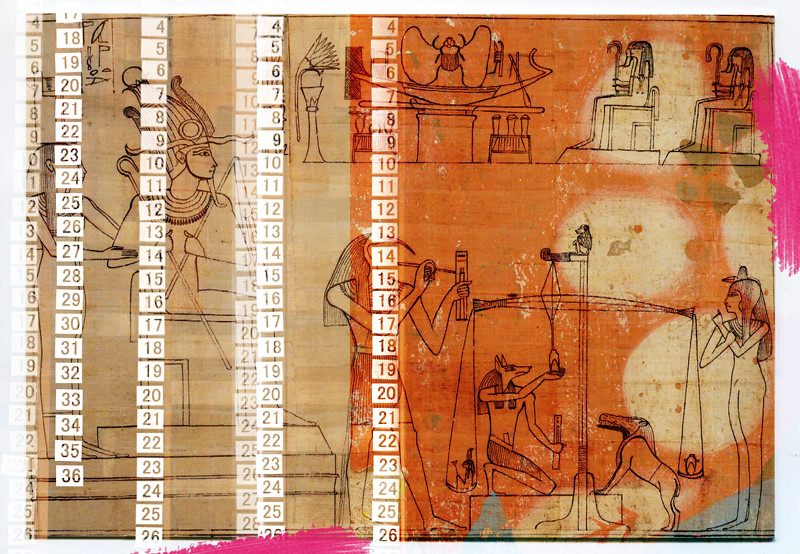
Musical Tinkle (II): visual poem by Marie Wintzer, 15 September 2012
So do many flowerpots come to you quickly, bringing you the black cat hobbling like a hushed crowd getting green and more bright after the coffee had run out.
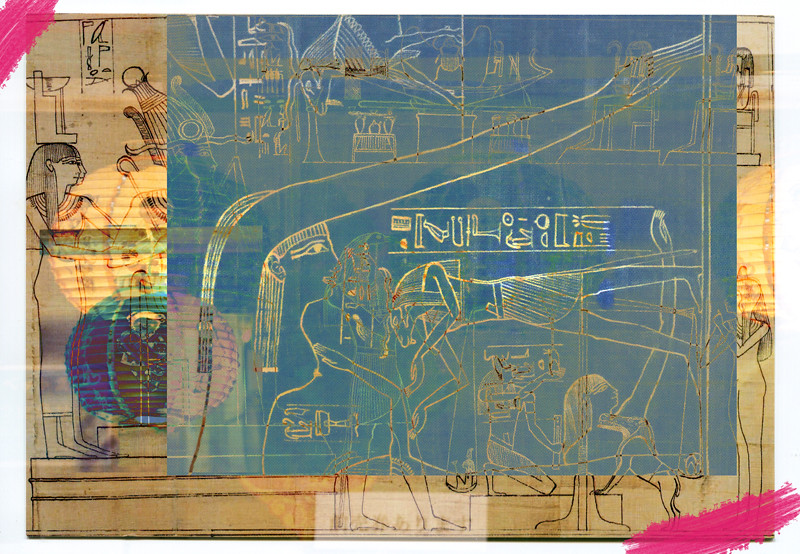
Musical Tinkle (III): visual poem by Marie Wintzer, 17 September 2012
Your request will be late late late! The far side will be found later. The person you wait for will go singing through the air. Building a new house and removal are both visible in the gloom. Marriage, employment and traveling are on only three legs.

Detail from the Greenfield Papyrus (the Book of the Dead of Nesitanebtashru), depicting the air god Shu, assisted by the ram-headed Heh deities, supporting the sky goddess Nut as the earth god Geb reclines beneath: unknown Egyptian artisan, c. 950 BCE; photo by the British Museum, from What Life Was Like on the Banks of the Nile, edited by Denise Dersin, 1997; image by A. Parrot, 13 June 2010 (British Museum)
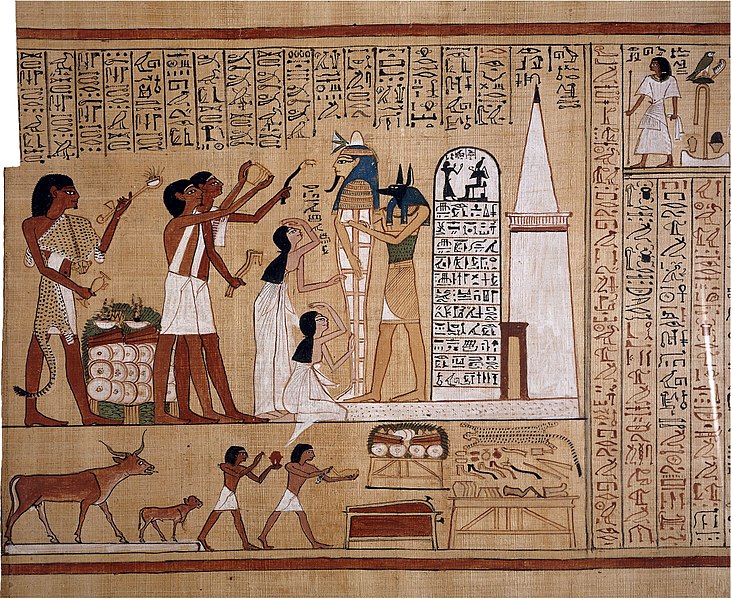
The Opening of the Mouth ceremony being performed before the tomb: page from the Book of the Dead of Hunefer: unknown Theban artisan, 19th Dynasty, c. 1300 BCE. The centrepiece of the upper scene is the mummy of Hunefer, shown supported by the god Anubis (or a priest wearing a jackal mask). Hunefer's wife and daughter mourn, and three priests perform rituals. The two priests with white sashes are carrying out the Opening of the Mouth ritual. The white building at the right is a representation of the tomb, complete with portal doorway and small pyramid. Both these features can be seen in real tombs of this date from Thebes. To the left of the tomb is a picture of the stela which would have stood to one side of the tomb entrance. Following the normal conventions of Egyptian art, it is shown much larger than normal size, in order that its content (the deceased worshipping Osiris, together with a standard offering formula) is absolutely legible. At the right of the lower scene is a table bearing the various implements needed for the Opening of the Mouth ritual. At the left is shown a ritual, where the foreleg of a calf, cut off while the animal is alive, is offered. The animal was then sacrificed. The calf is shown together with its mother, who might be interpreted as showing signs of distress (British Museum)
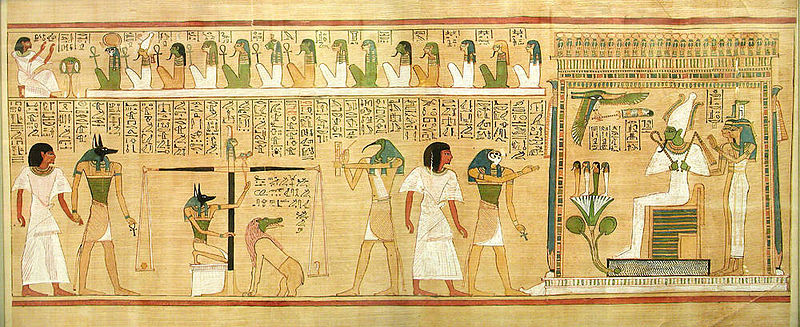
Weighing of the heart scene, with Ammit sitting: page from the Book of the Dead of Hunefer: unknown Theban artisan, 19th Dynasty, c. 1300 BCE. Hunefer is conducted to the balance by jackal-headed Anubis. The monster Ammit crouches beneath the balance so as to swallow the heart should a life of wickedness be indicated. Anubis conducts the weighing on the scale of Maat, against the feather of truth. The ibis-headed Thoth, scribe of the gods, records the result. If his heart is lighter than the feather, Hunefer is allowed to pass into the afterlife. If not, he is eaten by the waiting chimeric devouring creature Ammit, which is composed of the deadly crocodile, lion, and hippopotamus. In the next panel, showing the scene after the weighing, a triumphant Hunefer, having passed the test, is presented by falcon-headed Horus to the shrine of the green-skinned Osiris, god of the underworld and the dead, accompanied by Isis and Nephthys. The fourteen gods of Egypt are shown seated above, in the order of judges: photo by Jon Bodsworth, 8 December 2007 (British Museum)

Bridge in Macau: photo by Maitreya 8 (Mahesh Rao), 7 October 2011

Bridge in Macau (the haze is from industrial polllution): photo by Maitreya 8 (Mahesh Rao), 7 October 2011

Macau Tower: Flyovers in Macau: photo by Maitreya 8 (Mahesh Rao), 7 October 2011

Macau Tower: View from top: photo by Maitreya 8 (Mahesh Rao), 7 October 2011
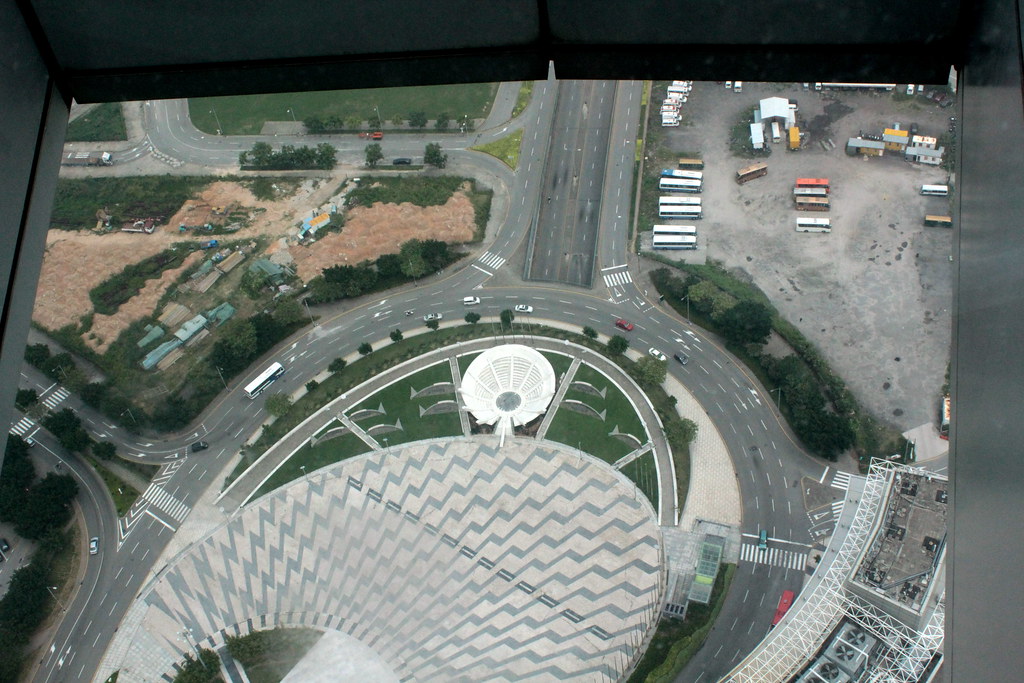
Macau Tower: View from top -- as seen from the glass bottom: photo by Maitreya 8 (Mahesh Rao), 7 October 2011

Shinjuku lights, Tokyo: photo by Tinu Bao, 25 December 2006

Lights from above (view from the overpass), Tokyo: photo by Tinu Bao, 25 December 2006
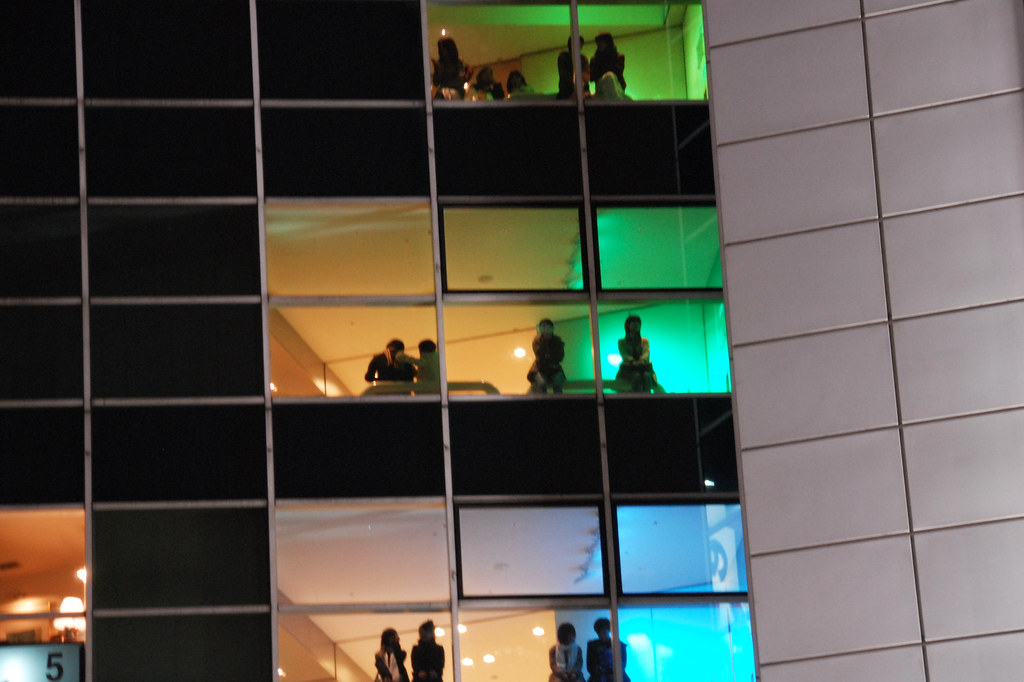
Windows, Tokyo: photo by Tinu Bao, 25 December 2006

Chicago, night: photo by photoalvin (Alvin Shubert), 22 May 2009

Chicago, night: photo by photoalvin (Alvin Shubert), 22 May 2009

Shinagawa rooftop view, Tokyo: photo by Thomas Birke, 2008

View from Shinagawa Prince East Tower 17F, Tokyo: photo by Thomas Birke, 2010


Traffic congestion, Tokyo: photo by spiraldelight, 2 January 2012

Highway #2, Los Angeles, California: photo by Edward Burtynsky, 2009, from Edward Burtynsky Photographic Work

Highway #5, Los Angeles, California: photo by Edward Burtynsky, 2009, from Edward Burtynsky Photographic Work
What some like to call angst and to ennoble as an existential is claustrophobia in the world: in the closed system.
It perpetuates the spell as coldness between men, without which the calamity could not recur.
Anyone who is not cold, who does not chill himself as in the vulgar figure of speech the murderer "chills" his victims, must feel condemned.
Along with angst and the cause of it, this coldness too might pass. Angst is the necessary form of the curse laid in the universal coldness upon those who suffer from it.
It perpetuates the spell as coldness between men, without which the calamity could not recur.
Anyone who is not cold, who does not chill himself as in the vulgar figure of speech the murderer "chills" his victims, must feel condemned.
Along with angst and the cause of it, this coldness too might pass. Angst is the necessary form of the curse laid in the universal coldness upon those who suffer from it.
Theodor Adorno: excerpt from Negative Dialectics, 1966, translated by E. B. Ashton, 1973

The Dream of Future Administered House: IPv6 exhibition at PT Telkom, Bandung, West Java: photo by Ikhlasul Amal, 12 November 2010
Reality's spell over spirit prevents spirit from doing what its own concept wants to do when faced with the merely existent: to fly.
Because more tender and fleeting, spirit is all the more susceptible to oppression and mutilation.
As the placeholder of what progress could be above and beyond all progress, spirit stands askew to the progress that does take place, and this in turn bestows honor upon the placeholder.
Through less than complete complicity with progress, spirit reveals what progress is really up to.
Because more tender and fleeting, spirit is all the more susceptible to oppression and mutilation.
As the placeholder of what progress could be above and beyond all progress, spirit stands askew to the progress that does take place, and this in turn bestows honor upon the placeholder.
Through less than complete complicity with progress, spirit reveals what progress is really up to.

Scranton, Pennsylvania: Historic Electric City sign, restored in 2008, shines again: photo by Carol M. Highsmith, 27 May 2008 (Library of Congress)
Like every philosophical term, 'progress' has its equivocations; and as in any such term, these equivocations also register a commonality.
What at this time one should understand by 'progress' one knows vaguely, but precisely: for just this reason one cannot employ the concept roughly enough.
To use the term pedantically merely cheats it out of what it promises: an answer to the doubt and the hope that things will finally get better, that people will at last be able to breathe a sigh of relief.
For this reason alone one cannot say precisely what progress should mean to people, because the crisis of the situation is that precisely while everyone feels the crisis, the words bringing resolution are missing.
What at this time one should understand by 'progress' one knows vaguely, but precisely: for just this reason one cannot employ the concept roughly enough.
To use the term pedantically merely cheats it out of what it promises: an answer to the doubt and the hope that things will finally get better, that people will at last be able to breathe a sigh of relief.
For this reason alone one cannot say precisely what progress should mean to people, because the crisis of the situation is that precisely while everyone feels the crisis, the words bringing resolution are missing.

Rooftop bar at Soho House, New York City: photo by pvsbond, 5 June 2007
Today reflections of this kind come to a point in the contemplation of whether humanity is capable of preventing catastrophe.
The forms of humanity's own global societal constitution threaten its life, if a self-conscious global subject does not develop and intervene.
Theodor Adorno: excerpts from Progress, Lecture at Münster Philosophers' Congress, 22 October 1962, translated by Henry Pickford in Critical Models: Interventions and Catchwords, 1998
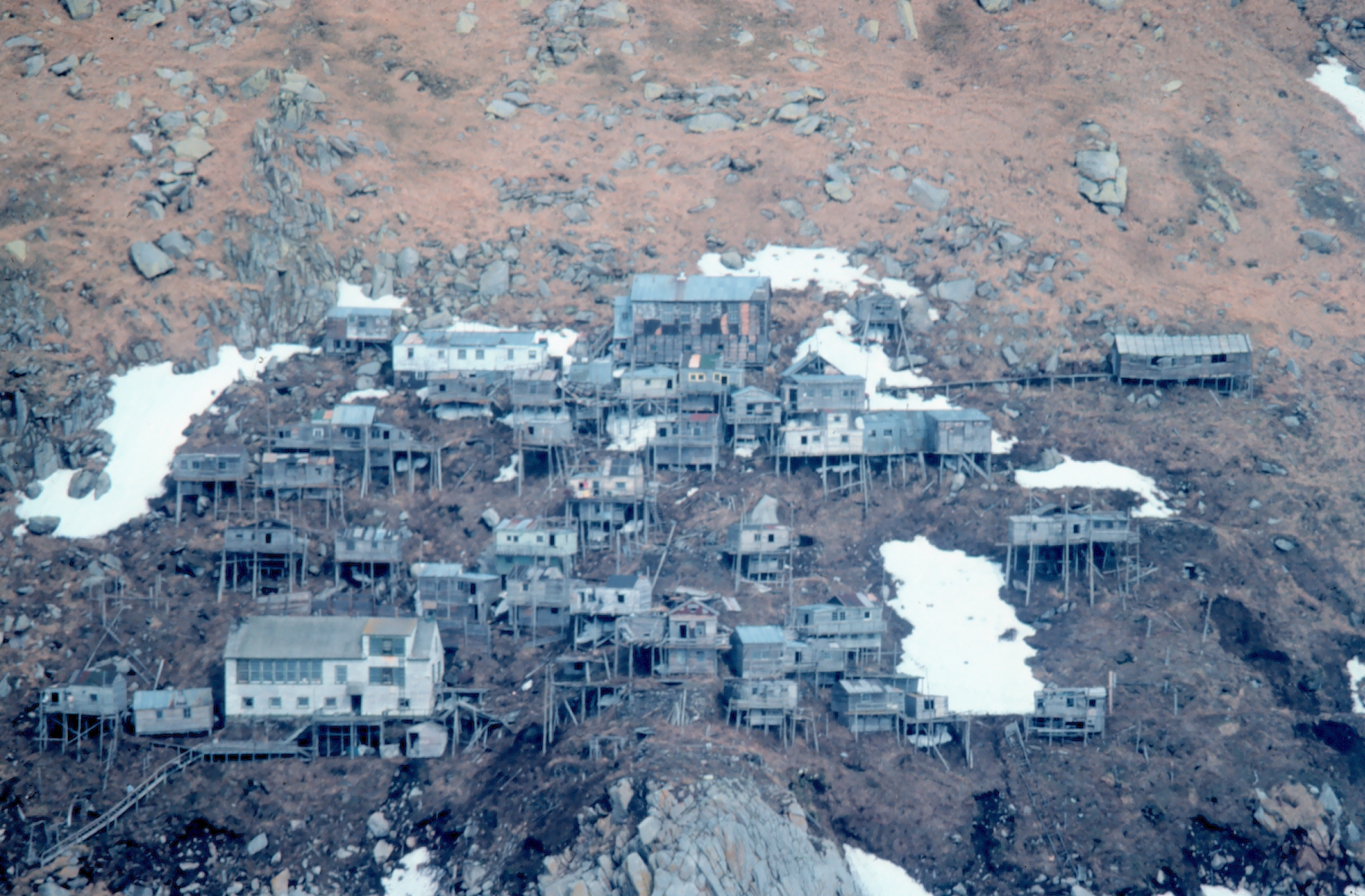
Deserted stilt village of Utivok, King Island, Bering Strait: photo by Capt. Budd Christman, 1978 (NOAA)